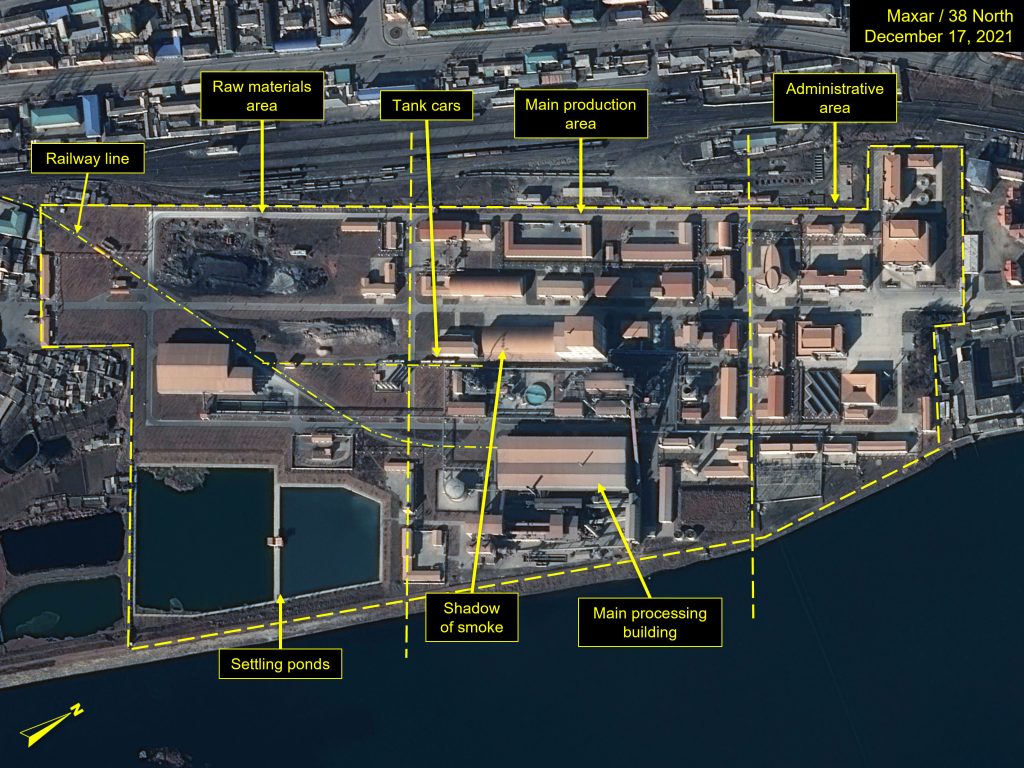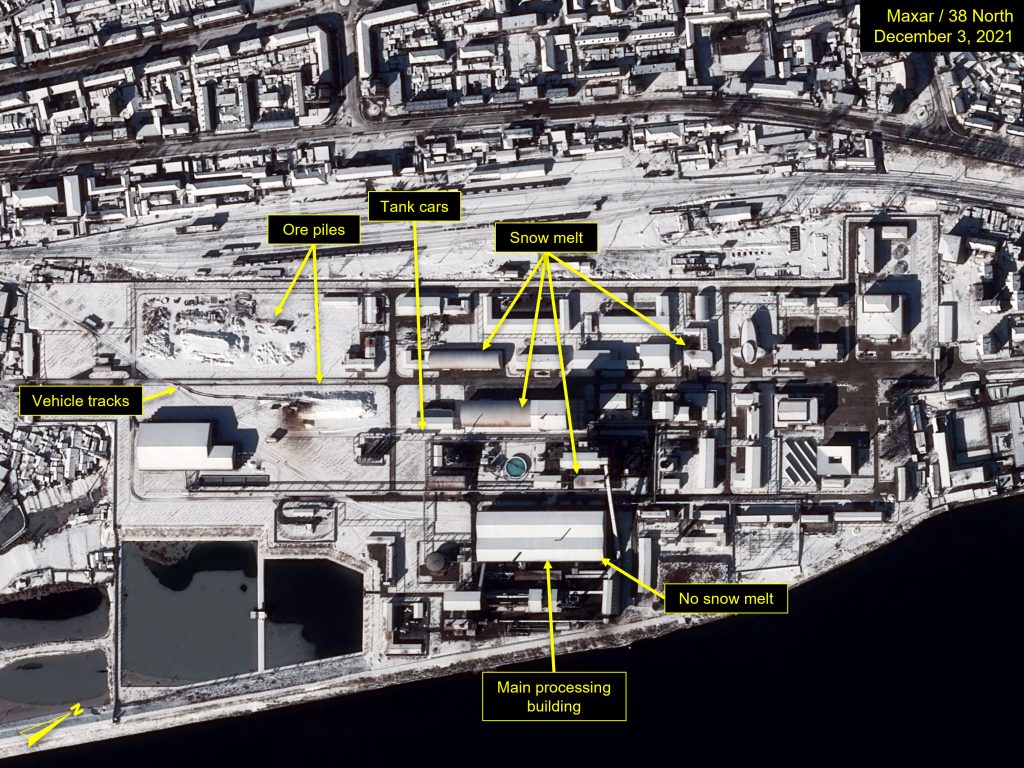Few Signs of Production at Sunchon Fertilizer Plant
The creation of an advanced chemical industry in North Korea would enable it to reduce its reliance on foreign imports of oil, plastics, fertilizers and raw materials, and boost domestic production of a wide range of essential chemicals for industry and agriculture. Developing the C1 chemical industry has been a high priority for Kim Jong Un, highlighted in his speeches since 2016.[1]
The Sunchon Phosphatic Fertilizer Factory (순천린비료공장), at the time of its opening in May 2020, was showcased as signifying progress on that effort.[2] Increasing domestic fertilizer production is especially important these days, with prolonged border closures raising the country’s dependence on domestic food production. However, questions have been raised about the operational status of the complex over the past two years, and recent commercial satellite imagery indicates the main processing plant is likely still not fully operational. These observations are consistent with statements in North Korean state media of continued problems at the factory.
Figure 1. Overview of Sunchon Phosphatic Fertilizer Factory.

Signs of a Slow Start
In April 2021, a year after the factory was declared open, 38 North reported that production appeared to still be in the early stages.
While some raw materials such as ore and coal were delivered to the site, smoke—an indicator of ongoing operations at key processing components—was not observed until October 2020. Moreover, the Sunchon Fertilizer Factory was notably missing from state media reporting of the 80-day production campaign results that year.[3] Such reports typically trumpet production successes at major plants; omitting this showcase plant all-but confirmed problems.
Admission of Problems
In July 2021, there were two state media reports that confirmed problems with plant operations.
The first, in Arirang Meari, disclosed that scientists from the Institute of Inorganic Chemistry at the Hamhung Branch of the State Academy of Sciences were sent to the plant to try and solve problems preventing full production.
In the fertilizer production process, a phosphate-bearing mineral is treated with sulfuric acid resulting in phosphoric acid. The phosphoric acid is then converted to ammonium phosphate with urea. It appears the problem exists in the latter stage of this process, although typically this should be a simple, well-established step.
When the factory was opened, display boards at the site showed the factory uses two different processes for fertilizer production: a wet and a dry process. The problem could lie in either of these processes, and it is possible North Korean researchers are using a non-standard or new process.
Whatever the reason, later the same month, Premier Kim Tok Hun visited the plant as part of a trip to the Sunchon area. A state media report on his visit concluded with a single line reporting that Kim “discussed and took measures to resolve the comprehensive issues arising in normalizing the production at the Sunchon Phosphatic Fertilizer Factory.”[4]
Since those disclosures, the media has been silent on work at the plant while reporting other factories, including the Namhung Youth Chemical Complex and Hungnam Fertilizer Complex, meeting or overfulfilling production targets.[5]
Satellite Imagery Clues
Satellite imagery collected during the summer and into winter of 2021 indicated some activity at the site throughout this period, including the movement of raw materials and smoke emissions coming from each of the major production areas at the complex.
However, the activity was below the level expected for a plant that is in full continuous operations. While the smoke indicated each of the major components of the production process had been operating, they don’t appear to have been working at the same time. For example, on December 17, the shadow of smoke coming from a stack in the main processing area can be clearly seen, but there is no visible smoke emanating from the other stacks.
On December 3, an image taken after a recent snowfall revealed the roof of the main processing building remained snow covered. If production was taking place, the internal heat generation would have caused at least some snow melt, especially as other buildings around the main production area exhibited snow melt.
Roads around most of the site were cleared of snow; however, this appeared to be still in process on the southern side of the complex around the ore piles. One of the ore piles showed signs of use, although vehicle tracks headed to a large building that sits alone on the site rather than the main production area.
Figure 2. Close up of snow-covered main processing and production areas.

On December 3 and 17, a set of railway tank cars was parked alongside a building in the main production area. Tank cars are used to bring in necessary chemicals such as sulfuric acid and ammonium. It is possible they were moved and returned to the same position, but if they have not moved (which is more likely), it is further evidence of the low level of activity at the site.
Other Fertilizer Plants
Although the Sunchon Fertilizer Factory is not yet running at full operations, the state has continued to push for increased production at the country’s two other major fertilizer production sites: the Hungnam Fertilizer Complex and the Namhung Youth Chemical Complex.
In July 2021, state media reported that both plants fulfilled their production quotas for the season. A month later, work began on expanding production at Hungnam Fertilizer Complex, and an October report said a new ammonia production process had been completed.[6] In December, Premier Kim Tok Hun called for production to be increased again at Namhung Youth Chemical Complex during a visit there.[7] On January 6, 2022, state media reported the Hungnam Fertilizer Complex was already working to meet production goals set at the recent party plenary meeting.[8]
In addition to technical problems at the North’s key fertilizer production facilities, the country still depends on the import of several raw materials for fertilizer production, such as urea. A global shortage of urea coupled with North Korea’s continued border closure represent just a few of the new challenges North Korea faces in trying to increase its self-sufficiency.
Additional research by Joanne Lee.
- [1]
In simple terms, C1 chemistry involves converting carbon compounds into other useful products that can have a variety of uses ranging from synthetic fuels to key industrial chemicals and fertilizers for agricultural use. Nearby anthracite mines provide a source for high-quality coal for the C1 industry. See also: “Supreme Leader Kim Jong Un’s Report to the Seventh Congress of the Workers’ Party of Korea on the Work of the Central Committee (Full Text),” KCNA, June 20, 2016.
- [2]
“Supreme Leader Kim Jong Un Cuts Tape for Completion of Sunchon Phosphatic Fertilizer Factory,” KCNA, May 2, 2020.
- [3]
“Their 80-Day Campaign Goals Achieved Successively,” Rodong Sinmun, December 12, 2020.
- [4]
“DPRK Premier Inspects Several Sectors of National Economy,” KCNA, July 24, 2020.
- [5]
See: “Farming Fertilizer Supply Plans Fulfilled in DPRK,” KCNA, July 22, 2020; and “Hungnam Fertilizer Complex Increases Production,” Rodong Sinmun, January 6, 2022.
- [6]
“Chemical Industry Reinforces Self-supporting Foundation,” KCNA, October 25, 2021.
- [7]
“DPRK Premier Inspects Major Industrial Establishments,” KCNA, December 12, 2021.
- [8]
“Hungnam Fertilizer Complex Increases Production,” Rodong Sinmun.
